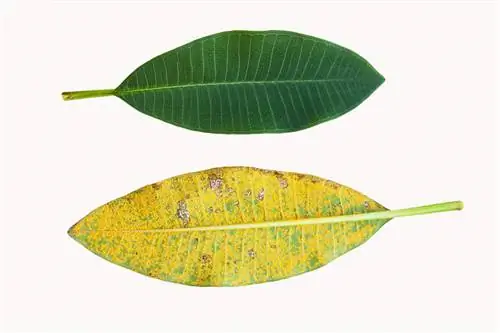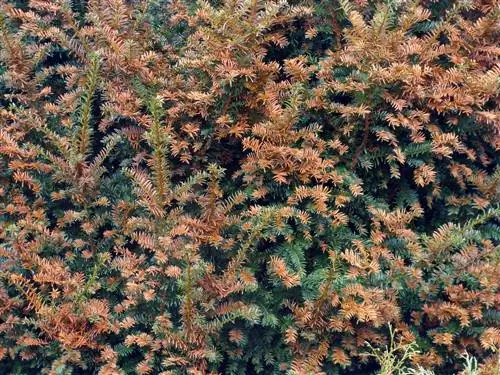- Author admin [email protected].
- Public 2023-12-16 16:46.
- Last modified 2025-01-23 11:22.
The Clusia, also known as the balsam apple, is considered extremely undemanding and easy to care for. But she is not immune to illness either. Under certain circumstances it can be colonized by fungi.

How do you recognize and treat fungal infestation in Clusia?
If the Clusia is infected by fungus, yellow leaves that later turn brown and limp, mushy shoots can occur. To save the plant, diseased parts should be removed and the Clusia repotted in fresh substrate. Prevention can be achieved through the right location, permeable soil and appropriate care.
Which fungal disease occurs with Clusia?
It is mainlyroot rot that can occur with Clusia. There are no other special diseases that can occur in houseplants with Clusia. As a houseplant, it is therefore relatively insensitive and robust to diseases.
How do you recognize a fungal infection on the Clusia?
Fungal infestation on Clusia can be recognized byseveral symptoms. These include, for example, yellow leaves that later turn brown. The shoots become limp and mushy. In addition, the balsam apple will not produce flowers and the soil will give off a musty smell over time.
How can Clusia be freed from fungus?
Sick parts of the Clusia should beremoved as quickly as possible. Afterwards, repotting the plant is crucial. The roots are stuck in wet soil populated by fungi. The old soil is therefore discarded and a new substrate is placed in the previously cleaned pot. With luck the Clusia will recover.
What factors promote fungal infestation in Clusia?
Especially too muchWetness promotes the development of a fungal disease in Clusia. Although it likes high humidity and likes to be sprayed, it does not like persistent wetness in the root area. Watering too heavily and frequently can quickly lead to wet roots. If there is also a planter and this moisture is not recognized, the risk of fungal infestation increases.
How can you prevent fungal infestation of Clusia?
Both a suitablelocation, a permeablesoiland the rightcare are crucial, to prevent fungal infestation of the Clusia.
When planting in a pot, choose a good substrate and mix it with a little sand or a special soil for succulents. The plant pot should have drainage holes so that excess water can drain away.
These points are also important to prevent fungal infestation:
- use low-lime water for watering
- only water when the soil surface is dry
- Location not in direct sun
- Room temperature
- fertilize every 14 days
What is important when removing diseased parts of the Clusia plant?
Since the Clusia ispoisonousand its sap can cause skin irritation, you should weargloves such as gardening gloves or rubber gloves when removing diseased parts of the plant carry. Dispose of the diseased leaves and roots of the Clusia immediately, as children and pets such as cats also run the risk of coming into contact with them.
Tip
Discolored leaves do not always indicate fungal disease
If the leaves of your Clusia are yellow or brown, it doesn't always have to be a fungal infection. The leaves can also become discolored due to excessive exposure to sunlight. It's like a kind of sunburn. Then place your Clusia in a sunny location.






